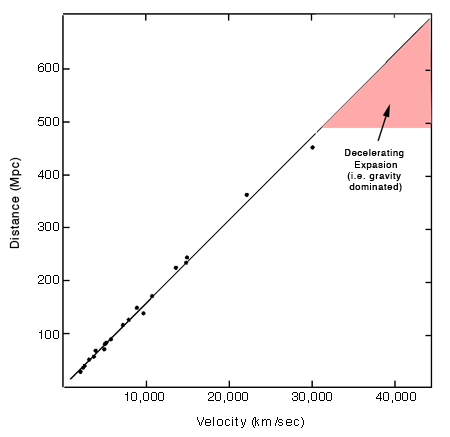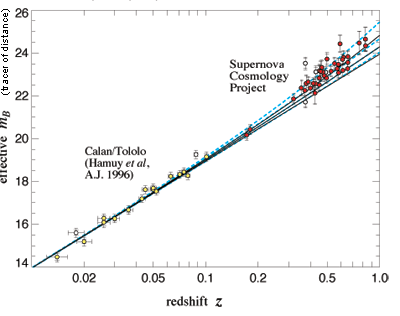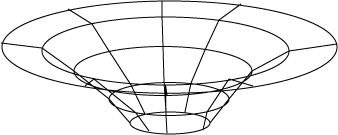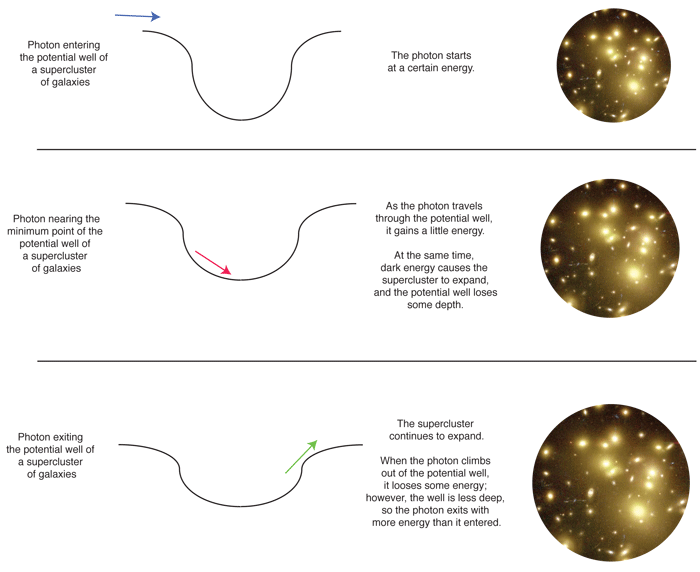Faster Walk on the Dark Side
There seems to be a feeling that there are no longer any mysteries left to discover in the Universe. Up until a decade ago, astronomers and physicists seemed to think that the only thing left was to iron out all the details. When the discovery of dark energy came along, the entire scientific community got excited. This type of revolutionary discovery is something that scientists dream of working on.
In this article introducing dark energy, we used the Integrated Sachs-Wolfe effect as the anchor point, but it is not the most important message of the article. Rather, it is more important for your students to understand that there is something out there that we hadn't previously observed, nor did current theories predict its presence. The discovery is so new that astronomers do not yet have a good handle on what it is, but they can characterize its observable effects on the large-scale structure of our Universe.
The Discovery
In the 1929 edition of Cosmic Times, Edwin Hubble had discovered that the further a galaxy was from the Earth, the faster it was receding. The relationship between distance and the velocity of a galaxy (or redshift of that galaxy) was a remarkably straight line. From this, we saw that the Universe was expanding. The straight line in the distance-velocity relationship indicates that the expansion occurs at an approximately constant rate over the timescales that we can measure.
Another thing to note about Hubble's Law is that when we look at further and further galaxies, we are really looking at slices of the Universe's history. This stems from the fact that light takes time to travel to us, so we really see objects as they were when the light was emitted. The light we receive from a galaxy that is 50 million light years away is showing us that galaxy as it looked 50 million years ago. In this way, astronomers will often use the ideas of distance and time in the Universe's past interchangeably.
As mentioned above, the data prior to 1997 pointed to a fairly constant rate of expansion in the Universe. However, astronomers did not expect that to hold indefinitely because of the expected effects of gravity. Of all of the fundamental forces in physics, gravity works over the largest distances, and it tends to pull things together. So, over long timescales, we would expect the expansion to slow down. Astronomers knew that at some distance, we should start to measure deviations from Hubble's Law due to this slowing expansion.
A natural question is, what would the Hubble plot look like once we start seeing deviations due to slowing expansion, as we assumed we should see. Consider a given redshift, or recession velocity, and recall that we are looking into the past with these observations. If the expansion rate has been slowing down, then these galaxies should be closer than they would have with constant expansion. So, we expect that the points should start to fall below the line, as illustrated below.

Plot of Hubble's Law, with the red region showing where points would start to fall if the expansion of the Universe is decelerating from the effects of gravity. (Image credit: based on image from Ned Wright)
Prior to 1998, this was what astronomer expected to find, if they could just observe galaxies at great enough distances. However, in 1998 two groups of astronomers measured distances to Type 1a supernovae in distant galaxies. (Recall that the 1993 Cosmic Times introduced the idea of using Type 1a supernovae as standard candles – it may be helpful to review the teacher's notes for that article). The groups also measured redshifts for the galaxies and added their data to a Hubble plot (distance versus redshift, or velocity). These new observations finally showed statistically significant deviations from the straight line normally seen in Hubble's Law. However, the deviation was not in the direction they had expected! Instead of the points starting to fall below the line, which would be expected from a slowing expansion due to gravitation, they found that the points started to fall above the line.

Hubble's Law showing the addition of distant Type 1a supernovae. Note that they all lie above the projected Hubble's Law (black line) from previous data. (Image credit: Perlmutter et al., 1999, ApJ 517, 565)
Scientists are cautious when it comes to revolutionary observations, so the change in astronomers' thinking did not change right away. The data needed to be tested further, and more data was needed before the idea of an accelerating expansion was fully accepted. However, all subsequent measurements using different independent methods confirmed that the expansion of the Universe was speeding up, rather than slowing down. This discovery changed our understanding of the Universe.
Note that in one of the associated lesson plans, titled Measuring Dark Energy, students reproduce the deviation from Hubble's Law for themselves with modern supernova data.
Integrated Sacks-Wolfe
One type of test of dark energy involves measurements of the cosmic microwave background (CMB). Recall that the CMB was created just a few hundred thousand years after the Big Bang (as discussed in the 1965 Cosmic Times article, "Murmur of a Bang" and the 1993 Cosmic Times article, "Baby Universe's 1st Picture"). Since the effects of dark energy become apparent only over the largest scales, more precisely over large timescales, the CMB is an ideal laboratory for dark energy studies.
As the article mentions, gravity is a property of matter, and often we depict a "gravitational well" around massive objects. Such a depiction is shown below.

Illustration of a typical depiction of a gravity well in spacetime. The well represents a place in spacetime where a massive object "dents" spacetime, causing an attraction between the object and other objects. The "well" in spacetime also causes the paths of light beams to bend near the massive object. (Image credit: NASA's Cosmic Times)
For the largest structures in the Universe (such as a supercluster of galaxies), dark energy will have a noticeable effect on the energy of a CMB photon crossing through its gravitational well. The photon gets a boost in energy when entering the gravitational well. Normally, the photon would lose that extra energy as it climbs back out of the well. However, dark energy stretches, and slightly squashes, the gravitational well over the time it takes the photon to travel across large structures. It takes less energy for the photon to escape the well than it received on the way into the well. So the exiting photon keeps a portion of that extra energy.

This illustration shows how the Sachs-Wolfe effect works. As a photon from the cosmic microwave background enters the potential well of a supercluster of galaxies, it starts with a certain energy. As it travels through the supercluster, the photon gains energy until it is at the bottom of the potential well. In the absence of dark energy, the photon would lose all of its gained energy on its trip out of the potential well of the supercluster. However, dark energy will cause the supercluster to expand, slightly shrinking the potential well. The exiting photon will retain some of the energy it gained on its trip through the supercluster. (Image credit: NASA's Cosmic Times)
When astronomers look across the sky, the spectrum of the CMB will be slightly different in regions where those photons have crossed gravitational wells that have been shrinking.
Other resources
The following web pages have more detailed information:
- Ingetrated Sachs-Wolfe Effect, with a nice animation of the CMB photons gaining energy as they pass through a supercluster.
- Dark Energy: Astronomers Still 'Clueless' About Mystery Force Pushing Galaxies Apart



